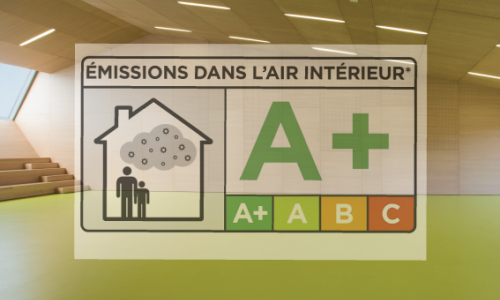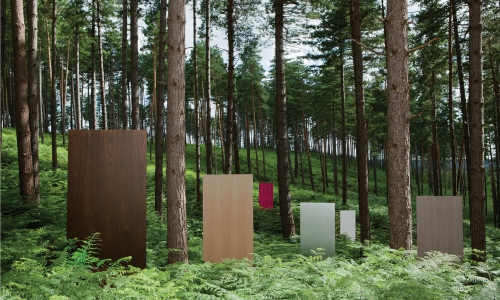Wood is both attractive and green
ADVANTAGE No. 1: Wood is a carbon sink
While they grow, the trees release the oxygen we breathe. At the same time, they absorb the atmosphere CO2 at an average rate of one tonne of CO2 per cubic metre of new wood.
This natural production of wood via photosynthesis continues throughout the tree's growth period. It ends when the tree reaches maturity: when it has finished growing, a tree no longer absorbs CO2.
Left in its natural state, a forest reaches a state of balance: dead trees decompose, releasing the CO2 they have absorbed. They are replaced by new trees which in turn absorb CO2.
Consequently, if the forest is not managed, the overall forest's carbon sequester is nil.
Harvesting trees that have reached maturity makes it possible to ensure that the CO2 absorbed during the trees' growth will remain trapped throughout the lifespan of the products manufactured from the wood, and provides an incentive to plant new trees in order to replace the ones that have been harvested.
Contrary to the common misconception which holds that using wood contributes to destroy forests, development of wood utilisation enables the preservation and sustainable development of forested areas.
1 cubic metre of new wood = 1 tonne of CO2 less in the atmosphere
ADVANTAGE No. 2: Wood is a renewable material
Contrary to the common misconception which holds that using wood contributes to destroy forests, development of wood utilisation enables the preservation and sustainable development of forested areas
When wood acquires a market value, this provides an incentive for preserving and developing forests. In Europe, forests are increasing by over 500,000 hectares every year and only 64 % of this growth is used. Consequently, the quantity of wood available increases every year.
As the environment-related regulations make sustainable forests management mandatory, using PEFC or FSC-certified wood is a guarantee that the harvested wood is subject to controlled renewal. The number of trees planted added to the number of trees grown due to natural renewal, is always higher than the quantity of trees harvested.
In France, and throughout Europe, forests are under-exploited and wood grows in great abundance.
Every second, the volume of European forests increases by the equivalent of approximately one wooden house.
ADVANTAGE No. 3: Wood is energy efficient
Wood is the only material that requires so little energy to be produced ! The energy consumed for the extraction and production of a material is called “production energy”. The higher it is, the more CO2 is emitted.
Compared to other materials, wood is very energy efficient in terms of production energy. It is even the only material that provides a negative carbon balance due to forests' “carbon sink” effect!
Compared to PVC, steel, aluminium, red brick or concrete, wood is the only material which provides a negative carbon balance.
ADVANTAGE No. 4: Wood stores CO2
Thanks to the photosynthesis process, wood absorbs CO2 and traps it during the life of the tree. But this CO2 sequestration continues once the tree is cut down.
When wood is used under a manufactured product form, either in the construction, renovation, development or decoration of a building, the CO2 trapped during the growth of the tree remains stored throughout the period of use of the product, which may be several hundred years. This storage of the CO2 continues even longer when the wood is reused or recycled for other uses.
Once cut, wood continues to store the absorbed CO2 throughout its period of utilisation.
ADVANTAGE No. 5: Wood is recyclable
When the period of use for which the wood-based product was manufactured comes to an end, wood can be reused or recycled to make panels intended for furniture or construction industries, for example. It then continues to store the CO2.
Although the majority of the wood-based panels are from sawmill by-products (off-cuts, sawdust), the portion of recycled wood in their manufacturing increases constantly.
The quality standards guaranteeing the manufacture of panels that are eco- friendly and are not harmful to public health are established by the European Panel Federation. These set the percentage limits of impurities, above and beyond which wood cannot be recycled for producing panels. Many studies have been conducted in order to create new markets for recycled wood: wood/plastic composites, accessories for animals (cages, baskets, stable fittings, etc.), soil preparations (mulch, playing areas, etc.), material for compost, etc.
Reused or recycled wood continues to store CO2.
ADVANTAGE No. 6: Wood is a clean form of energy
By-products from wood production and manufacturing process (bark, sawdust, shavings, production rejects, etc.) as well as wood-based products which can no longer be recycled, are burned and used as an energy source, thereby completing wood's “virtuous” cycle.
Wood then takes the place of traditional fossil fuels, supplying energy with a neutral CO2 balance: the CO2 released by the combustion of wood is equivalent to the amount that the wood absorbed during its growth. This combustion does not therefore contribute either to the greenhouse effect or to global warming.
Wood's energy is “clean” because it avoids being placed in landfill as well as minmises waste disposal costs. The impurities produced by combustion are filtered within energy production units before being discharged via smokestacks.
When it burns, wood releases no more CO2 than it absorbed during its growth.







